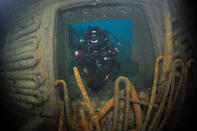The Katzu Maru

Average depth: 25 m
Maximum depth: 32 m
The Katzu Maru, which sank in 1972 in the Hout Bay Harbour mouth, is an oriental trawler which is still virtually intact and easily accessible. She lies on a stark sandy bottom on her starboard side at a 45 degree angle at a depth of 27 m on deck and 32 m on the sand. This wreck makes for a good wreck training dive. There are a lot of fish and other marine life typical of the Atlantic Ocean on this ship and large fish often visit the area. Seals are present and fish such as Hottentots, Steenbrashs, Galjoen and other fish species are plentiful. There are hard and soft corals and colourful Nudibranchs to see all over the wreck while Shortspine urchins, as well as colourful anemones, are also seen. Keep an eye out for various Chitons, colourful sponges and other invertebrates. A torch is needed for this dive, and because of her depth, this is a dive for more experienced divers.
The Astor
Average depth: 25 m
Maximum depth: 33 m
In April 1997, the Astor, a lobster catcher (27 m long and 340 tons) was going to be scrapped. Cape Town divers saw this as an ideal opportunity to extend an existing artificial reef system within the protected environment of Hout Bay. She was cleaned, freed of oil and sunk by August 1997. She now lies peacefully, 20 m to the north of the Katz Maru in 33 m of water, providing a thrilling penetration dive in relative safety. Shortspine urchins, as well as colourful anemones and an abundance of fish, are seen on this wreck. Large fish are also known to visit this area.
Vulcan Rock
Average depth: 19 m
Maximum depth: 30 m
Vulcan Rock is a large and deep pinnacle about 2 km offshore from Hout Bay. It rises to the surface and drops off to over 30 m – furthermore, a large tunnel can be found at the bottom of the pinnacle. This site can be very clear but also icy cold. It is often successful as a drift dive and is generally reserved for the more experienced diver due to the depths you can reach and the current which is often present. At 19 m one can see the open cave. Large fish often visit this area and seals are present most of the time. Deepwater Cowries and curious crayfish are everywhere to be seen.
Lion's Paws
Average depth: 18 m
Maximum depth: 26 m
This site is ideal if you are looking for something fairly deep. There are two large pinnacles tapering to small islands which stick out above the surface – these make for a very nice dive with wonderful overhangs and caverns to explore. The two sites are very similar and have very colourful scenery and there is a lot of fish and other marine life on both of the dive sites.